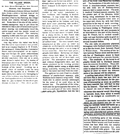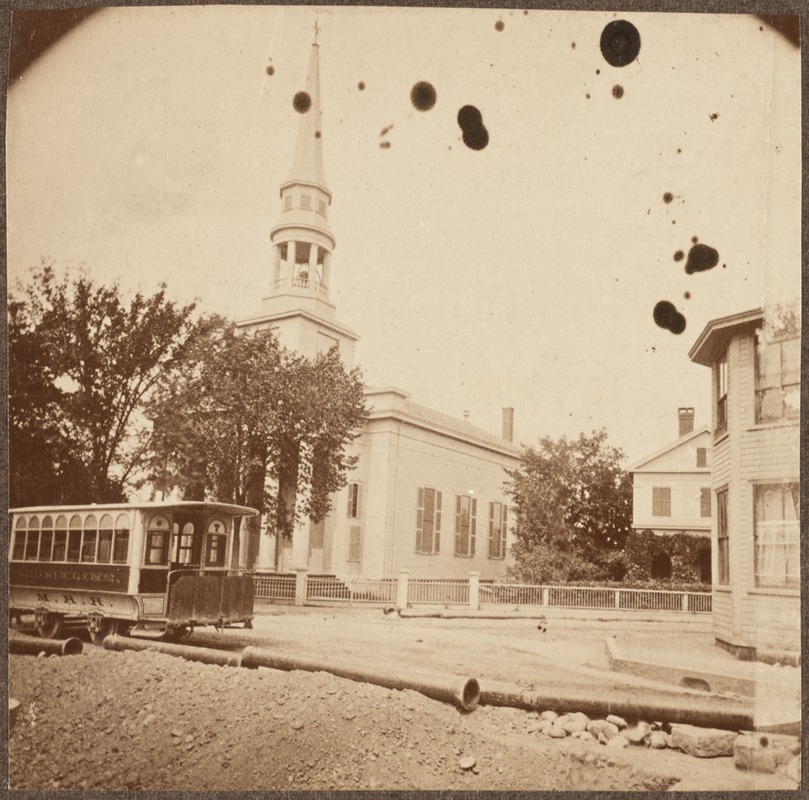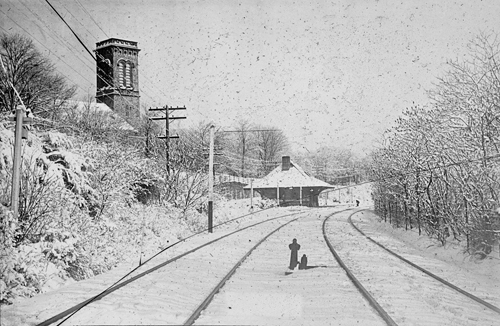 |
Brookline Village, circa 1909
The new fire station, just completed in 1908, is partially visible on the left followed by M. W. Quinlan’s carriage shop. Visible on the right are John H. Shea, Horse Shoer at 21 Boylston St.; J. O'Day, Stables at 19 Boylston St.; Crawford O' Hart, Tinsmith and Coleman and Horton, Cigars at 11 Boylston St.
The trolley car is from the Boston and Worcester Street Railway Co. The route started at Park Sq. sharing standard trolley tracks then switched to its own B & W tracks at an interchange just west of Chestnut Hill. The route continued to Worcester and the cars could travel at 60 mph once outside the local Boston environs. The telescoped photo obscures the fact that these cars were longer than the local trolley cars running in Brookline.
|
 |
Brookline Village, circa 1873
This unique photo is a rare photo of the early stages of the expansion of Brookline Village northward away from the business center on Lower Washington St. It shows the first two buildings of Colonnade Row which have just been built and populated with the initial businesses. A third building would be added on the right in 1875. All are still standing as are the original cast-iron pillars visible on the store fronts.
The horse-drawn car is being pulled on rails which were first laid in 1859 to effect a much-needed improvement over the slow and bumpy rides of the trackless Omnibuses which were essentially enlarged stage coaches. This horse car is being pulled northward either to the final stop at Washington and School Streets or to the final stop at Harvard and School Streets. At these final stops the horse(s) would be unhitched and attached to the other end of the car and the route retraced.
There are three stores in the building on the left:
- The first store, at #243, appears unoccupied
- In the middle, at #239, is the dry goods store of Walter Martin
- On the right, at #235, is the grocery store of George F. Joyce who would later expand and relocate up the street
There are three stores in the building on the right:
- The store on the left, at #227, is the apothecary of Charles P. Ladd
- In the middle, at #223, is the store of George Turnbull, the first tailor in Brookline
- On the right, at #219 Washington St., is the Brookline Savings Bank which had just been incorporated in 1871
In the distance the old railroad depot can be glimpsed with a sign for the American Telegraph Company. It also housed the post office.
[Source: Leo Sullivan]
|
 |
Relocation of the Village Brook, February, 23, 1894
Tom Condon, Sr. Civil Engineer for Brookline writes:
The work shown is part of the relocation of the outlet of the Village Brook. …(in the pile of lumber in the background you can see a piece of the curved falsework used
to hold the brick arch until the cement mortar set.). Leverett Pond was created from the Muddy River marsh located just south of Washington Street by installing a stop plank manhole (in effect an adjustable height dam) in the new culvert under Washington Street. This stop plank manhole was necessary to hold back the pond since the Charles and therefore the Muddy Rivers were still tidal at that time. Presumably, Alexis French (who was both Olmsted's engineer and the Town Engineer) determined that more flow into this new pond was necessary. To provide this additional flow, the Village Brook which flows alongside what is now the MBTA "D" line was diverted into the culvert shown under construction. The culvert runs east down Washington Street, crosses Walnut Street, runs down Morss Avenue (now discontinued), across Pond Avenue and into Leverett Pond.
|
 |
Boston & Albany Tracks, Brookline Village
Looking east on the Boston and Albany railroad tracks, today’s “D” line. From west to east:
- Washington St. overpass
- The top of the building at 171-173 Washington St., no longer standing
- The train station platform
- Businesses on the north side of Pearl St. including Brookline Coal Co.
[Source: Leo Sullivan]
|
 |
Brookline Village: Chestnut Hill Trolley (Boylston St. - Ipswich St. - Brookline Ave.)
|
 |
Brookline Village Train Station, 1874
This is the oldest known photograph of the full train station in the Village. Visible are the signs for the post office and the telegraph, both of which were housed in the depot. Visible in the rear is a train parked on a side track.
[Source: Brookline Public Library]
|
 |
Boston and Albany Rail Station, Brookline Village
Looking east. The partially-visible building behind the station at 31 and 34 Station Street still stands.
|
 |
Brookline Village Train Station, circa 1885
At Station St., looking west under the Washington St. bridge. Only entrance to White Place.
Tom Condon, Sr. Civil Engineer for Brookline writes:
It would be interesting to note that the roadway passing under the bridge to the right of the railroad was the only access to White Place at the time since it was a dead end street. When the bridge was later widened, it was also shortened so as to only cross the railroad tracks. The end of White Place was filled in to meet the grade of the new bridge. That is the reason for the retaining wall between White Place and the "D" line which is located about where the center support of the bridge is.
|
 |
Railroad Station, Brookline Village
Heading east, current location of Brookline Village "D" Line stop of the MBTA. Station St. to the left
|
 |
Washington St. at School St.
Standing on Washington St. looking north at the Bethany Building. School St. is to the right. The steeple is in the first of three iterations, it was reduced in size over time. Known as the “Bethany Building”, the church was constructed in 1844 as the first church in Brookline of the newly-organized Harvard Congregational Society. The building was sold in 1873 as the Society prepared to move to a larger structure at the corner of Harvard St. and Marion St. After a brief stint as a Methodist church followed by several additional changes of ownership, the building was acquired in 1887 by the Bethany Sunday School Association which held it for the next twenty years. The building was torn down in 1928.
The horse-drawn car is being pulled on rails which were first laid in 1859 and has reached its final stop at Washington and School streets. At these final stops the horse(s) would be unhitched and attached to the other end of the car and the route retraced. This car #7 is also seen in another Village photo, that one dated 1873.
[Source: Digital Commonwealth]
|
 |
Trolley on Washington St.
Looking north toward Beacon St, passing Park Ave. on the right Right to left: #465 and #471, apartment buildings still stand. Summit Ave. hill visible in the background
[Source: Joel Shield]
|
 |
Chapel Station, Carlton & Colchester St.
Flag station for the Boston and Albany Railroad and pedestrian crossing; the southern end of Carlton St. is on the left; note same man as in the Longwood Station photo and the other man at the left hand corner of the building
|
 |
Longwood Flag Station, Boston and Albany Railroad
By the Longwood Ave overpass, looking east; Sears Chapel in the background; note same man as in the Chapel Station photo
|
 |
Longwood Station, Boston and Albany Railroad
[Source: Iowa State]
|
 |
Longwood Station, Boston and Albany Railroad, 1930
Looking east. Chapel St. is on the left.
|
 |
Sear's Chapel, Longwood Station, Muddy River
|
 |
Longwood Ave. Trolley, 1891
This rare photo shows the trolley traveling westward having just passed St. Paul St. on its way to Coolidge Corner. It is approaching the house of Charles Dudley at 60 Longwood Ave. Dudley, who had recently purchased the property, would soon move his house to the west and sell the expanded corner property, vacant in the photo, to Jacob Bates who constructed his house there.
This trolley line would soon be eliminated and the tracks, which only ran on the north side of Longwood Ave., removed.
[Source: Leo Sullivan]
|
 |
Boylston St. Trolley, 1910
Traveling inbound in the area of Chestnut Hill Ave.
|
 |
Boylston St. at Hammond St.
Boylston St. looking west from Hammond St. Louis Henry Graves opened his drug store at 1186 Boylston St. circa 1907 after working at the Young and Brown drug store in Coolidge Corner. He sold the business circa 1924.
|
 |
Boylston St. at Hammond St.
[Source: Brookline Preservation Department]
|